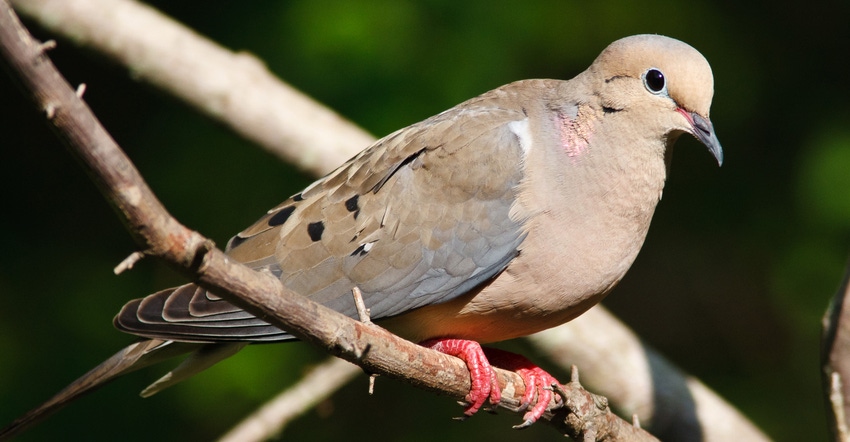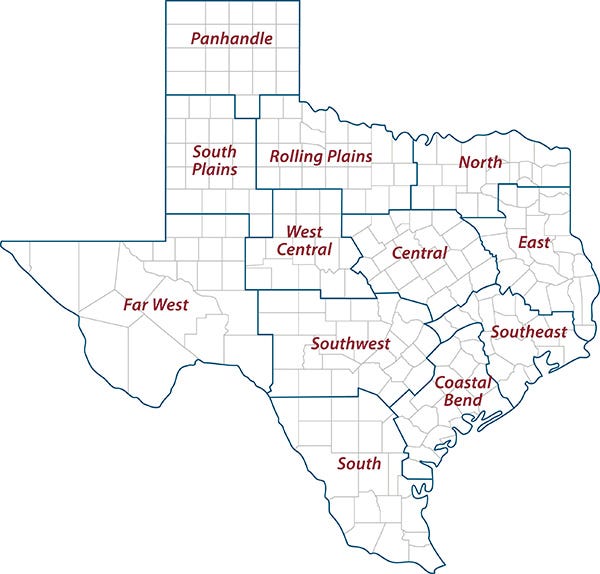
Texas hunters should expect a promising number of dove in flight as the 2020 hunting season kicks off, according to John Tomacek, Texas A&M AgriLife Extension wildlife specialist, Thrall.
Hunting is an activity that appears to be trending upward due to COVID-19, Tomacek said. Dove season, which begins Sept. 1, will be most hunters’ first foray into the field this hunting season.
“At least among state residents, hunting license sales are up, and we’re expecting good participation this year,” he said. “People are looking for reasons to be outdoors because of the pandemic, and many are choosing to go hunting.”
2020 dove forecast
Owen Fitzsimmons, Texas Parks and Wildlife Department dove program leader, Austin, reported “ripe conditions for a fruitful season” in his 2020 dove season forecast.
Fitzsimmons said the 2020 dove surveys were cancelled due to the pandemic, but Texas has a breeding population of 25 million mourning doves and up to 15 million white-winged doves. Dove populations swell during hunting season as birds migrate into the state from other areas in the flyway.
Like previous seasons that kicked off during prolonged dry spells, hunting spots with food and water sources nearby should attract birds.
“Above-average rainfall statewide throughout the spring season has led to prime habitat conditions during the peak nesting months of May and June,” he said. “Biologists suggest that dry condition in the northern and western regions of the state may help concentrate birds around food and water sources during the season.”
Fitzsimmons said timing hunts around normal seasonal weather like cold fronts will be instrumental in hunter opportunities. Dove concentrate in bigger fall flights ahead of fronts.
“These groups will often feed heavily in one area for a few days before moving on,” he said. “Hunters should look to take advantage of any fronts during the season.”
Improve dove harvesting opportunities
Tomacek said location will be a major factor in hunter success. Having small grains like sorghum or seed crops like sesame and sunflowers on or nearby hunting locations attract birds.
“This year may be different for many areas because of commodity prices,” he said. “If acres that were typically sorghum were planted with corn this year, that will likely affect the number of doves in the area.”
It’s also important to know the rules for manipulating seed and grain crops as a way to attract migrating dove, Tomacek said.
“For people who planted crops like sunflowers to attract dove, the birds aren’t going to perch on the plants and eat the seeds,” he said. “You have to shred it down and spill the seed. That is legal for migratory dove. If you’ve planted for dove, it is legal to manipulate the crop and hunt over it.”
Tomacek recommends spending some time preparing your aim before the hunt.
“A little practice with some clay pigeons will help get your brain in shape for how your gun is patterning and how much you’ll need to lead the birds,” he said. “Shoot a consistent load, the same load and shell, whether it’s 6s or 7s. It’ll increase your chances of bagging birds.”
AgriLife Extension district reporters compiled the following summaries:

CENTRAL
Drought conditions worsened. A small amount of rainfall was reported, but not enough to change soil moisture conditions. Some counties initiated burn bans. Forecasts called for rain. Pastures were drying out pretty rapidly. Livestock producers were feeding hay and/or cubes. Livestock were in fair to poor condition. Hay prices were going up. Irrigated crops were in good shape. Sorghum and corn harvests were complete. Cotton exhibited signs of drought stress. Half the district reported short soil moisture levels, and the other half reported very short conditions. Nearly all counties reported poor rangeland and pasture conditions.
ROLLING PLAINS
Some areas received beneficial rains, which helped improve topsoil conditions. Cotton was in fair to good condition and was setting bolls. Wheat producers began plowing and fertilizing fields in preparation for planting. Pasture and rangelands remained dry. Cattle were being fed minerals and hay in areas where forages were in short supply.
COASTAL BEND
Some areas received 0.5-3 inches of rainfall from scattered showers throughout the week, but other areas remained dry. Corn harvest was almost complete. Cotton harvest was in progress and being hurried along by the threat of tropical disturbances in the Gulf. Soybeans were being harvested. Rice harvest was over halfway complete. Rangeland and pasture conditions were declining due to short soil moisture, but some areas reported improvement due to significant, isolated rainfall. Hay was being made, but overall hay inventory was expected to be short. Livestock water availability was also a concern. Pecan trees were shedding nuts due to dry conditions.
EAST
The dry spell continued across the district. Pop-up showers occurred in a few counties. Despite the lack of rain, pasture and rangeland conditions remained good. Subsoil and topsoil conditions were adequate to short. Hay production continued. Watermelons and peas were being harvested. Calf prices were up at local cattle markets. Livestock were in fair to good condition. Armyworms were reported in Cherokee County. Wild pig activity increased in pastures, hay meadows and crops.
SOUTH PLAINS
Conditions remained very dry. Sporadic rains fell across the district with most recording trace amounts. Cotton was still setting bolls. Pumpkins were doing well across the district. Some farmers were starting to harvest corn for silage. Sorghum was maturing well moving into the final stages. Peanuts were still progressing. Cattle were in good condition with supplemental feeding, but some livestock were being culled due to drought.
PANHANDLE
Northwestern parts of the district reported adequate topsoil and subsoil moisture. Central and southern areas reported very short topsoil and subsoil moisture levels. Pasture and rangeland, corn and cotton were in good to fair condition in most areas, but poor to fair in southern parts of the district. Sorghum was completely headed in most of the district. Peanuts were in good to fair condition.
NORTH
Most counties reported short to very short topsoil moisture due to high temperatures and sporadic rain. Pasture and crop conditions were declining. Pastures and ponds were drying up very fast, and there were reports of pond fish mortality. Armyworm activity was heavy.
FAR WEST
Temperatures dropped slightly but remained in the upper 90s and above 100 degrees with nighttime lows in the mid-70s. Irrigated cotton had set bolls and looked good. Very little dryland cotton made it this year. Small circles of irrigated peanuts were pegging and doing well. Corn was harvested, but yields were lower than expected. The few sorghum fields that were harvested were yielding below expectations. Watermelon harvest was complete, and yields were decent. Hay producers made another cutting. Livestock were in good condition despite the weather. Pastures and rangelands were in terrible shape. More fires were being reported. Burn bans were in effect for most counties to help prevent fires. Pecan producers were still watering their orchards as nuts continued to fill. Producers were also placing pecan weevil traps.
WEST CENTRAL
Some parts of the district received some light rain but not enough to help with soil moisture conditions. Sorghum and corn harvests were mostly complete. Dryland cotton harvest was done, and some irrigated fields were at cut out. Pastures were dry, and creeks and tanks were low. Some fall wheat planting was expected to begin soon. Many farmers and ranchers were having to feed hay and protein to livestock.
SOUTHEAST
Some areas received brief rainfall, which maintained their moisture levels. Other areas remained dry. Livestock were in good condition throughout the county. Rangeland and pasture ratings were excellent to very poor with fair ratings being the most common. Soil moisture levels ranged from adequate to very short with adequate levels being the most common.
SOUTHWEST
Parts of the district received trace amounts up to 1.6 inches of rain. Temperatures were in the upper 90s and into the triple digits. Pasture and rangeland conditions needed moisture. Corn and sorghum harvests were complete, and Guadalupe County reported good yields. Peach season wrapped up. Livestock were in fair to good condition. Livestock markets were holding steady. Fall shearing began. Supplemental feeding for both livestock and wildlife continued.
SOUTH
Weather conditions were hot, and soil moisture levels were adequate to short. Temperatures were in the high 90s and into the 100s. Lines of sporadic rain delivered spotty rains across the district. Maverick and Live Oak counties reported 0.75-2 inches of rainfall. Tropical systems were expected to deliver rainfall and possible severe weather. Corn and sorghum harvests were complete. Cotton fields were being defoliated in areas, and harvest was underway in other areas. Strawberry acreage was being prepared for early plantings. Peanut fields continued to develop and were being irrigated. Pasture and rangeland conditions continued to decline in drier areas. Producers with irrigation were making hay. Livestock producers indicated a slight increase in supplemental feeding for livestock. Some producers were culling herds. Food plots were being prepared. Ground was being prepared for cool-season forages. Pond levels were dropping dramatically, and wildlife and livestock were beginning to suffer. Irrigated crops like watermelons and cantaloupes were producing good harvest, and Coastal Bermuda grass pastures were producing good hay bales. Spinach planting was expected to begin by the end of next week. Pecans continued to develop following heavy irrigation water applications. Some producers were preparing fields for dove season. Hunters were providing wildlife with corn, cotton seed and supplements in preparation for hunting season.
Source: is AgriLife TODAY, which is solely responsible for the information provided and is wholly owned by the source. Informa Business Media and all its subsidiaries are not responsible for any of the content contained in this information asset.
Read more about:
HuntingAbout the Author(s)
You May Also Like




